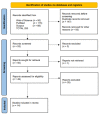Is Spontaneous Preterm Prelabor of Membrane Rupture Irreversible? A Review of Potentially Curative Approaches
- PMID: 37509539
- PMCID: PMC10377155
- DOI: 10.3390/biomedicines11071900
Is Spontaneous Preterm Prelabor of Membrane Rupture Irreversible? A Review of Potentially Curative Approaches
Abstract
There is still no curative treatment for the spontaneous preterm prelabor rupture of membranes (sPPROM), the main cause of premature birth. Here, we summarize the most recent methods and materials used for sealing membranes after sPPROM. A literature search was conducted between 2013 and 2023 on reported newborns after membranes were sealed or on animal or tissue culture models. Fourteen studies describing the outcomes after using an amniopatch, an immunologic sealant, or a mechanical cervical adapter were included. According to these studies, an increase in the volume of amniotic fluid and the lack of chorioamnionitis demonstrate a favorable neonatal outcome, with a lower incidence of respiratory distress syndrome and early neonatal sepsis, even if sealing is not complete and stable. In vivo and in vitro models demonstrated that amniotic stem cells, in combination with amniocytes, can spontaneously repair small defects; because of the heterogenicity of the data, it is too early to draw a thoughtful conclusion. Future therapies should focus on materials and methods for sealing fetal membranes that are biocompatible, absorbable, available, easy to apply, and easily adherent to the fetal membrane.
Keywords: amniopatch; amnios; fetal membranes; healing membrane; premature rupture of membranes.
Conflict of interest statement
The authors declare no conflict of interest.
Figures
Similar articles
-
Amniopatch treatment for preterm premature rupture of membranes before 23 weeks' gestation and factors associated with its success.Taiwan J Obstet Gynecol. 2017 Oct;56(5):599-605. doi: 10.1016/j.tjog.2017.08.005. Taiwan J Obstet Gynecol. 2017. PMID: 29037543
-
Amniopatch treatment for spontaneous previable, preterm premature rupture of membranes associated or not with incompetent cervix.Fetal Diagn Ther. 2013;33(1):47-54. doi: 10.1159/000342418. Epub 2012 Oct 17. Fetal Diagn Ther. 2013. PMID: 23076290
-
Residual amniotic fluid volume predicts the sealing of preterm prelabor rupture of fetal membranes in the pre- and periviable period.Taiwan J Obstet Gynecol. 2023 Jul;62(4):543-546. doi: 10.1016/j.tjog.2022.09.016. Taiwan J Obstet Gynecol. 2023. PMID: 37407191
-
Interventional resealing of preterm premature rupture of the membranes: a systematic review and meta-analysis.J Matern Fetal Neonatal Med. 2022 Dec;35(25):5978-5992. doi: 10.1080/14767058.2021.1903858. Epub 2021 Aug 16. J Matern Fetal Neonatal Med. 2022. PMID: 34392785
-
[Management of preterm prelabor rupture of membranes with respect to the inflammatory complications - our experiences].Ceska Gynekol. 2013 Dec;78(6):509-13. Ceska Gynekol. 2013. PMID: 24372427 Review. Czech.
Cited by
-
Role of Myofibroblasts in the Repair of Iatrogenic Preterm Membranes Subjected to Mechanical Stimulation.Prenat Diagn. 2025 Jan;45(1):102-112. doi: 10.1002/pd.6722. Epub 2024 Dec 4. Prenat Diagn. 2025. PMID: 39631799 Free PMC article.
References
-
- Bond D.M., Middleton P., Levett K.M., van der Ham D.P., Crowther C.A., Buchanan S.L., Morris J. Planned early birth versus expectant management for women with preterm prelabour rupture of membranes prior to 37 weeks’ gestation for improving pregnancy outcome. Cochrane Database Syst. Rev. 2017;3:CD004735. doi: 10.1002/14651858.CD004735.pub4. - DOI - PMC - PubMed
-
- Lorthe E., Torchin H., Delorme P., Ancel P.Y., Marchand-Martin L., Foix-L’Hélias L., Benhammou V., Gire C., d’Ercole C., Winer N., et al. Preterm premature rupture of membranes at 22-25 weeks’ gestation: Perinatal and 2-year outcomes within a national population-based study (EPIPAGE-2) Am. J. Obstet. Gynecol. 2018;219:298.e1–298.e14. doi: 10.1016/j.ajog.2018.05.029. - DOI - PubMed
Publication types
LinkOut - more resources
Full Text Sources


